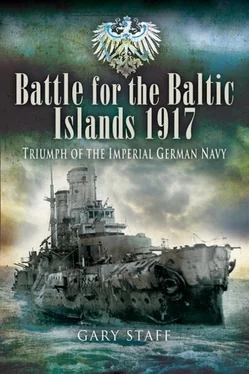The operation was code named ‘Albion’ and the following day the troops entrained for the port of Libau. The Army forces consisted of the reinforced 42nd Division, commanded by General von Estorff, and the 2nd Infantry Cyclist Brigade, together with artillery, pioneers, a wireless section and transport column. In total the Landing Corps consisted of around 23,000 men, 5,000 horses, 1,400 vehicles, 150 machine-guns, 54 guns, 12 mortars and munitions and provisions for thirty days. To convey the Landing Corps to their assault beaches in Tagga Bay, on the northwest coast of Ösel, a transport fleet of nineteen steamers was assembled. It was to be the largest combined operation undertaken by the Germans so far during the war. To support the operation the most modern units of the High Sea Fleet were detached and were formed into the Special Unit of the Baltic. The composition of the Special Unit was as follows:
Chief of Special Unit: Vizeadmiral Schmidt
Chief of Staff: Kapitän zur See Levetzow
Flagship: Moltke .
III Battle Squadron
Commander:Vizeadmiral Behncke
König , Bayern , Grosser Kurfürst , Kronprinz , Markgraf
IV Battle Squadron
Commander: Vizeadmiral Souchon
Friedrich der Grosse , König Albert , Kaiserin , Prinzregent Luitpold , Kaiser
II Reconnaissance Group (II AG)
Commander: Kontreadmiral Reuter
Königsberg , Karlsruhe , Nürnberg , Frankfurt , Danzig
VI Reconnaissance Group (VI AG)
Commander: Kontreadmiral Hopman
Kolberg , Strassburg , Augsburg , Blitz , Nautilus
Torpedoboats
I FdT (Führer dur Torpedoboote or Leader of Torpedoboats):
Kommodore Heinrich
Flagship: Emden
II Torpedoboat Flotilla (10 boats)
VI Torpedoboat Flotilla (11 boats)
VIII Torpedoboat Flotilla (11 boats)
X Torpedoboat Flotilla (11 boats)
7th Torpedoboat Half Flotilla (7 boats)
U-Flotilla Kurland
6 U-boats.
Sperrbrechergruppe(literally Barrier-breaker Group)
Rio Pardo , Lothar , Schwaben , Glatz
II Minesweeper Flotilla
3rd Minesweeper Half Flotilla
4th Minesweeper Half Flotilla
8th Minesweeper Half Flotilla
3rd S-Half Flotilla (S- denotes a ‘picket’ or anti-submarine unit)
S-Flotilla of the Baltic
Netbarrier Unit of the Baltic
Fleet Train.
Appointed to lead the Special Unit was the hitherto commander of the I Battle Squadron, Vizeadmiral Ehrhard Schmidt. He was an excellent choice. Vizeadmiral Schmidt had begun the war as commander of the IV Battle Squadron, stationed in the Baltic. This led to him being appointed commander of the first attack on the Riga Gulf in August 1915. The campaign lasted from 8 to 21 August. The first attempt to break in to the gulf failed because of the insurmountable mine barriers. A continuation of the attack led to a German force entering the gulf for a short period on 19 August. Prinz Heinrich came to the conclusion that a recurrence of the break-in attempt
Would only make sense when we could remain in the Gulf. For this purpose it is necessary for the Army to occupy Riga and the mouth of the Dvina. Then the possession of the Gulf can be facilitated, but nevertheless would require considerable naval forces. Only the capture of Ösel and Dagö will simplify the operation and provide an anchorage for the large ships, and also provide opportunities for us to approach the fortified points of the Finnish Gulf.
Riga fell in September 1917 and the situation now allowed the Germans to prosecute their attack plans.
The Russians had long perceived the threat to the Baltic Islands and as early as August 1914 the Fleet Commander, Admiral H O Essen, had said:
Today the 1st Torpedoboat Division was sent to Moon Sound and Riga Gulf, and workbegan on installing batteries for the protection of Moon Sound. I attach great value to the maintenance of communications with the islands of Ösel and Dagö. The occupation of the latter by the enemy would deprive us of advanced observation posts and aviation stations and would entail the loss of Moon Sound.
Theoretically the Riga Gulf and islands were reasonably well protected. Ösel was defended by three infantry regiments, the 425th, 426th and 472nd, who together with the coastal batteries had a strength of around 24,000 men. Tagga Bay was protected by Battery No 45 with four 15.2cm guns at Cape Hundsort and Battery No 46, likewise with four 15.2cm guns, at Cape Ninnast. Work on these batteries had been started on 10 December 1916 and they were completed in April 1917. On Dagö, Battery No 34 was constructed at Serro, a little west of the village of Emmast. It comprised four 120mm guns taken from Amur class monitors and had been completed in early 1916. Dagö was defended by a further two batteries at Cape Tachkona. Battery No 38, of four 15.2cm guns, was mounted at Cape Simpernes and Battery No 39, at Cape Tachkona, consisted of four 12 inch guns. Battery No 37 at Cape Dirhamn consisted of four 15.2cm guns, which, like those of Battery No 38, were also taken from Amur class gunboats. The southern entrance to the Moon Sound was also well protected with batteries. Five 254mm pieces that were originally intended for Nargon Island on the ‘Central Position’ were sent to Moon Island and were installed as Battery No 36 near Woi. However, only two guns could be mounted on concrete bases and the remaining three were mounted on wooden bases. This battery was ready on 5 July 1915. Battery No 32, between the villages of Woi and Resse, consisted of four 15.2cm pieces and was ready on 13 September 1915. A battery on the mainland side, on the island of Werder, completed the southern Moon Sound entrance defences. This battery, No 33, comprised four 15.2cm guns.
The main battery of the island defences was Battery No 43 placed at Cape Zerel. This battery was constructed under extremely difficult conditions. The 12 inch gun barrels weighed 50.7 tonnes each and everything had to be brought to Zerel by barge. In addition to the mountings, power plants, barracks and magazines had to be constructed. When first test fired in April 1917, the four 12 inch guns had the portentous range of 152 cable lengths (one cable equalling 200 yards or approximately 183 metres) and not only covered the entire Irben Straits, but also the shore of the Kurland coast. However, advantage of this reach could not always be taken because of frequent fog and mist, especially in autumn, when visibility did not exceed 90 to 100 cables. Nevertheless, this extremely important battery had a couple of drawbacks. The installations were in the open, without protection, and the magazines were constructed of timber and earthworks with oak doors. This would later have tragic consequences.
There were two other batteries on the Zerel Peninsula. Battery No 40, of four 120mm cannons, was built near Karust and Battery No 41, of four 130mm guns, was positioned between Mento and Lebera. Most of the aforementioned batteries were well protected by numerous 75mm anti-aircraft gun batteries.
The second part of the defences of the Irben Straits were the extensive minefields laid over a long period. Since the beginning of the war the Russians alone had laid over 10,000 mines in the Irben Straits, and the Germans had laid thousands more along the Kurland coast as part of their so-called ‘mine shield’. However, from the Russian point of view, there were no guarantees the mine position could be supported. The southern coastline of Kurland lay in German hands and they were thus able to conduct minesweeping operations close under the coast, without the support of their fleet units. These minesweepers, however, frequently came under attack from Russian destroyers and gunboats operating in a swept area under the Sworbe Peninsula, the so-called ‘manoeuvre basin’, and also from the newly-commissioned Zerel battery. The struggle between laying and sweeping mines continued over 1915, 1916 and 1917 and was referred to as the ‘static war’, or a maritime version of trench warfare. The southern Moon Sound was protected by two large minefields of around 1300 mines.
Читать дальше












